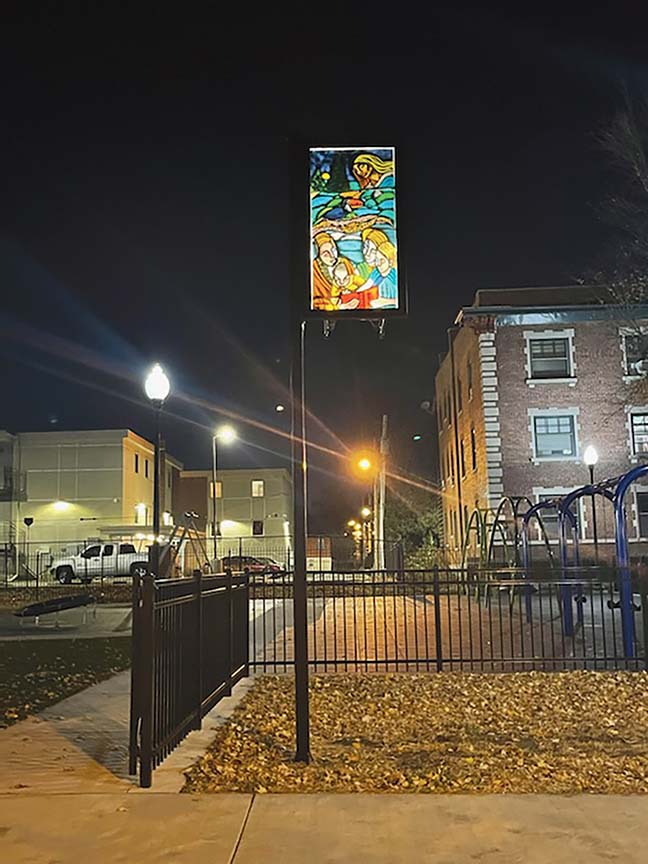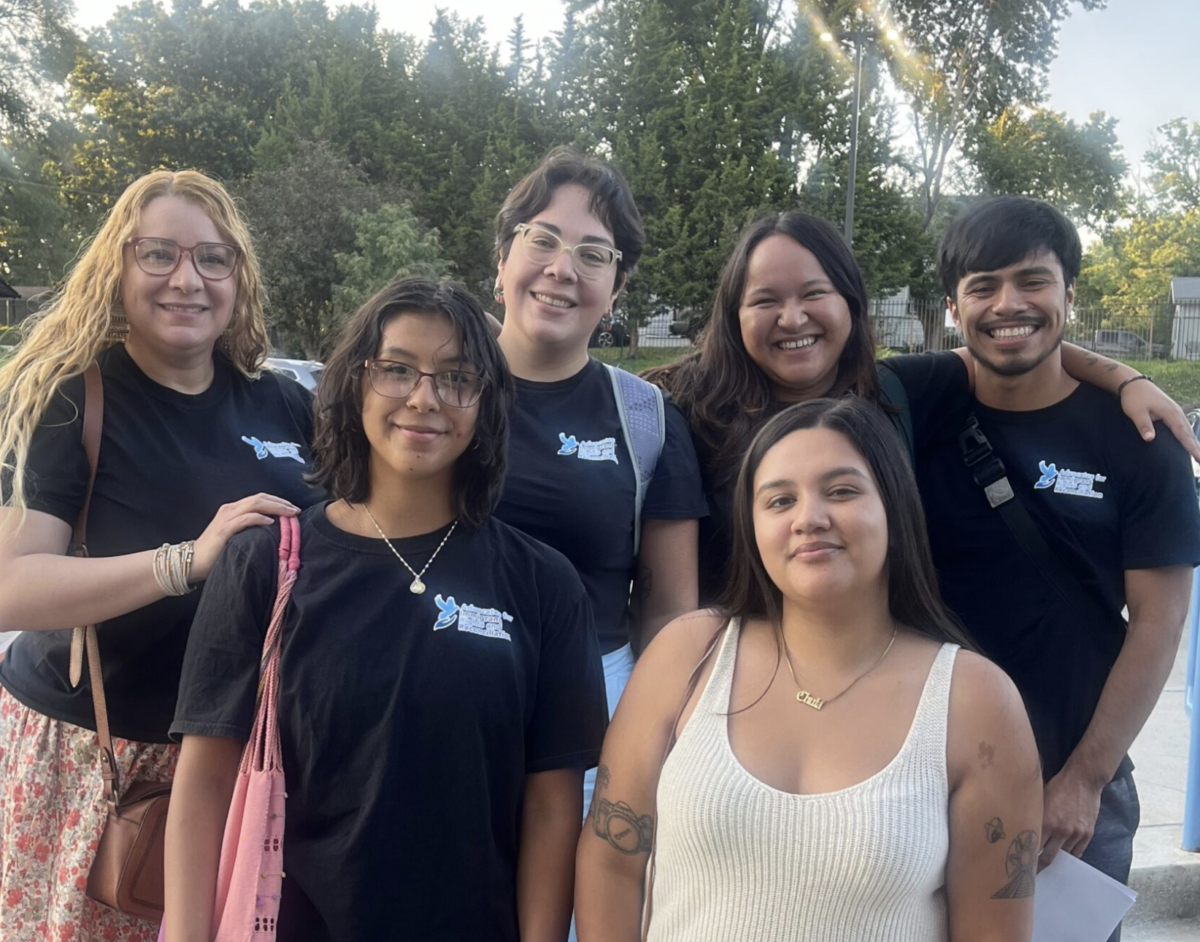
Abby Hoover
Managing Editor
Artist Hasna Sal’s creativity is shining bright over a second Historic Northeast park as part of a $1.2 million renovation of Independence Plaza Park at Independence and Brooklyn avenues.
The three lighted glass panels are secured to light poles along the Avenue on the north side of the park at the playground.
Creating this new series was a full circle moment for Sal, whose first installation in the neighborhood was at Lykins Square Park, a memorial to victims of human trafficking.
“The new work is about the children,” Sal said. “People have always asked me, ‘What happened to the women?’ Now they’re in their homes.”
The survivors of trafficking that Sal has met and connected with are living amazing lives, she said.
“They are very strong women, and incredible mothers,” Sal said.
“Motherhood is one of the main reasons how and why they emerged, they broke free, from the shackles of human trafficking and they’ve become incredibly strong women raising families.”
She was so inspired by their stories that each panel is dedicated to a specific victim of human trafficking that she knows personally. The three panels show the narrative of caring, sharing and nurturing.
In conjunction with her recent installation, the Economic Growth Gallery (EGG) at 2659 Independence Ave. is hosting Sal’s exhibit “Into the Light,” which she said is the backstory of the two park installations.
“What is really cool about this whole construct is that, first of all, we are acknowledging we have a problem in our community, which is human trafficking,” Sal said. “Missouri ranks seventh in the nation for human trafficking. We are acknowledging as a community, the leaders are acknowledging that we have a problem. But we are solving the problem, and public art is being used as a platform for change, for raising awareness.”
At Lykins Park, the panels illustrate how a trafficked person gets trapped into trafficking, and how she finds a way to emerge from it.
“And over here [at Independence Plaza Park], the story continues about how now she is strong and giving back to the community,” Sal said. “So it’s speaking to the strength of the women of Northeast, of Kansas City, the strength of the women of our community, and how there is so much resilience in us and that any woman can do anything she wants to do, if she has the willpower to do it, and these women are living proof of it.”
As visitors walk through the park, they will see the installation, but the panels are installed perpendicular to Independence Avenue, so that pedestrians and drivers can also see them.
“What I found is that when I went to the park before, I saw homeless people there, I saw meth heads over there, saw people drunk, and I didn’t see a single child in that park,” Sal said. “I’ve been there a few times. But since that installation happened and since the Parks Department created the new facilities and everything with the playground, it’s a combination where the Kansas City Parks and Rec have completely revamped the space, made it beautiful, revitalized it, and with my installation as well, I think that the combination of it has transformed the park.”
Sal has visited the park a few times since her art was installed, and she has noticed a difference – both during the day and at night.
“I see it full of children, and in the nighttime, it’s glowing in the dark and it keeps the people at bay,” Sal said. “They are away from the park. I see across the street, there’s a liquor store, and the people there don’t come into the park.”
She sees her installation, especially at night, as the face of the park, creating a gateway and saying “This is about the children, don’t pollute this holy space. This is about the purity of little minds playing in there, let them be.”
Even when she was installing the work in the park, children playing in the park came running to see what she was doing.
“One of the things that children gravitate towards is color,” Sal said. “They are simple minds, reds and blues and greens, so I have strategically used on a lot of color, saturated my panels with color so that the children gravitate towards it and they see the message inside, which is caring, nurturing, community, friends, family, these are the the aspects of it.”
Sal wants to change the narrative – and the nature of the park – using color, light and a strong message.
“The parks of our nation are cesspits for criminal activity because in the dark, when it’s poorly lit, that’s the best place for criminals to congregate and do what they do,” Sal said. “But my installations at nighttime become the most glorious, they become tremendously colorful.”
Sal has added more color and more light than she did in the installation at Lykins.
“What criminals hate is to be seen,” Sal said. “This is the beauty of public art. If you can make public art not just about the aesthetic, but for a greater message – which is reforming a community – if you can achieve that, then I think that is the highest level that public art can reach. That’s what I’m striving to do every single time.”
The idea for the new project came from Bobbi Baker-Hughes, CEO of the Northeast Kansas City Chamber of Commerce, and others. But the inspiration came from observing children. Her first panel was dedicated to human trafficking survivor Melissa, who is depicted teaching her child to ride a bike.
“I love children. I love observing children. It makes me very happy to see that,” Sal said. “They love to be in the park, they love to ride their bike in the summertime.”
Sal said Melissa is an amazing poet and a great mom. Teaching her child to ride a bike symbolizes steering her child through life.
“It always connects with me what trafficking survivors say, ‘I want to get out of this because I don’t want my children to go through what I went through,’ and I could see the living proof of that because there’s just such incredible mothers,” Sal said.
The second panel, with relationships, birds, butterflies and nature, is dedicated to Robyn.
“Robyn is just, my goodness, she’s just an incredible person,” Sal said. “When I first spoke with her, she was crying for her friends who had died through this crime of trafficking, and she kept saying to me, ‘How come I’m alive? How come I’m alive?’”
Robyn has four daughters who she has been able to give a much more secure upbringing than she had, and Sal was inspired by what a kind person she has become, despite her trauma.
“She has a relationship with her significant other, and then she has a son that she had not seen for the longest time who came back into her life,” Sal said. “She always talks to the spirits of her deceased sisters, as she calls them, and how she connects with them. There’s so many layers to her personality.”
There are so many people in Robyn’s life – some are deceased, some are alive, but they’re all a part of her life – and she’s a person who’s surrounded by new life, and she’s a survivor.
“My work as an artist is all about bringing out the extraordinary in the ordinary, which is what I’ve done with Lykins,” Sal said. “Ordinary people, actually those who are marginalized, who like to be in the shadows. When I created this work, Robyn said to me, ‘Hasna, my whole life, I’ve always felt ashamed. My father called my children trick babies. I’ve always been ashamed. But you made me out to be a hero and I want to come into the light.’”
The third panel is dedicated to Maije, a victim of domestic violence, who left behind an 18-month-old son when she was killed.
“I showed that education is something that is not just a singular thing,” Hasna said. “But when education happens, it’s a family effort. It’s not a single effort, and so that’s why I did that panel about education.”
Missouri ranks third in the nation for domestic violence, and Sal thinks it’s all connected. Hearing Maije’s story, and learning that all she wanted was an education for her son, broke Sal’s heart.
“This was like my inspiration for this panel, it came from Maije, and how that’s all she wanted, and now she’s no more,” Sal said. “We don’t want more like Maije in our community, you know, and so it’s a reminder for not only the children but for us also as adults.”
Sal wanted to share that there are strong, resilient, and hurting women in this community. Less than 1% of the victims of human trafficking make it out alive, and Hasna is continuously amazed by those who make it out and make something of themselves.
“The transformation has been completed, and what I love about this installation is as it gets darker, and it becomes scarier, the work becomes more illuminated,” Sal said. “It’s almost like I am here, like a watchdog… It’s always about casting light on the ordinary, casting light on those who are in the dark.”
The installation was funded by a $30,000 grant from the Independence Avenue Community Improvement District (CID) and a small grant from the Kansas City Museum. On display at the EGG until November 17, visitors can see Sal’s work during Northeast News business hours, 9 a.m. to 4 p.m. Monday through Friday.



















